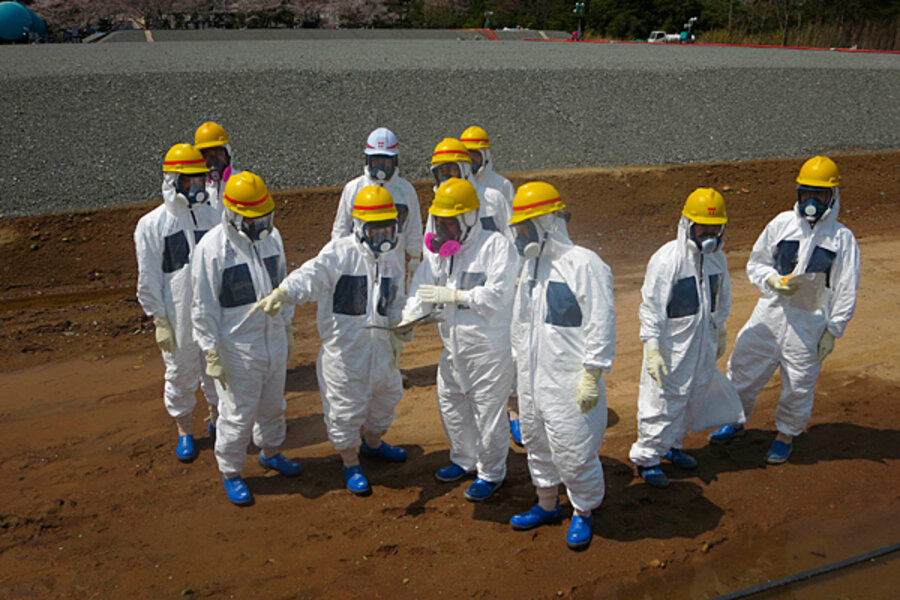Fukushima 101: 5 questions answered about Japan's crippled nuclear reactors
Loading...
| Tokyo
Three of six Fukushima Daiichi reactors suffered core meltdowns during the earthquake and tsunami of March 11, 2011. The plant is still leaking contaminated water into the ocean, and work has yet to begin on decommissioning. Tens of thousands of evacuated residents, meanwhile, do not know when, or if, they will be able to return.
Q: How stable is the situation at the Fukushima reactors?
The plant's operator, Tokyo Electric Power (Tepco), brought Reactors 1, 2, and 3 to a stable state known as "cold shutdown" – meaning that the temperature of the water cooling the nuclear fuel rods remains below the boiling point – in late 2011, so there is no immediate risk of another meltdown. There is concern, though, about the safety of 1,300 spent fuel assemblies being stored near the top of Reactor No. 4, which was weakened by an explosion in March 2011. Recognizing the need to place these in safe storage, Tepco plans to begin the unprecedented task of removing the spent fuel assemblies in November. The operation is expected to last a year.
Q: What needs to happen before the reactors can be considered "safe"?
Some areas of the plant have radiation levels that are still so high that they are inaccessible to humans. The site itself is still far from safe for the workers there, although the threat of dangerous atmospheric radiation releases over a wider area has passed. The consensus is that the site will not be completely safe until the molten fuel in three reactor basements has been removed – a dangerous process expected to take about 40 years. Workers will have to continue pumping coolant water into the reactors for years, until the molten fuel reaches a state in which it can be air-cooled. Therein lies another problem: Nuclear officials admit they are not sure exactly where the fuel is resting.
Q: How has the situation been handled?
Badly. In the early days of the disaster, Tepco was criticized for acting too slowly to inform the public about the gravity of the accident, although the government has won praise from the United Nations, among others, for quickly ordering the evacuation of communities near the plant. Since the disaster, Tepco's response has been dogged by mishaps, including power cuts, shoddy construction of water tanks, and the use of substandard equipment to monitor radiation. Tepco's reluctance to quickly disclose problems at the site has added to public mistrust of the utility and sparked calls for the formation of an international task force to oversee the decommissioning of the reactors.
Q: What's the major concern now?
Water. This summer, Tepco finally admitted that as much as 300 tons of contaminated ground water was seeping into the Pacific Ocean every day. The ground water flows down from the hills behind the plant and mixes with water that is being used to cool the reactors. It also emerged that several tanks used to store toxic water pumped out of the reactor basements had sprung leaks, sending radiation in the immediate vicinity to dangerously high levels. There are ambitious, and costly, plans to build an underground "ice wall" to prevent ground water from reaching the reactors, and to replace poorly constructed storage tanks prone to leaks. The water leaks have caused anger overseas, prompting South Korea last month to impose a ban on all fish imports from a large area of Japan.
Q: Was it the reactors' design, their location, or simply a lack of planning that resulted in the crisis?
On-line reactors at Fukushima Daiichi automatically shut down when the magnitude-9.0 earthquake struck Japan's northeast coast March 11, 2011. While there is disagreement over whether the meltdowns were triggered by the earthquake or the ensuing tsunami, it is the latter that caused the most damage. Tepco had ignored warnings that the area was prone to very powerful tsunamis; waves as high as 46 feet easily breached the plant's 19-foot protective seawall, while its backup power generators, located perilously close to the ocean, were quickly rendered useless. In the quest to keep costs down, Tepco, aided by Japan's toothless nuclear regulators, had failed to prepare Fukushima Daiichi for a major natural disaster. It is for that reason that a key report on the Fukushima disaster published in July 2012 described it as "man-made."






